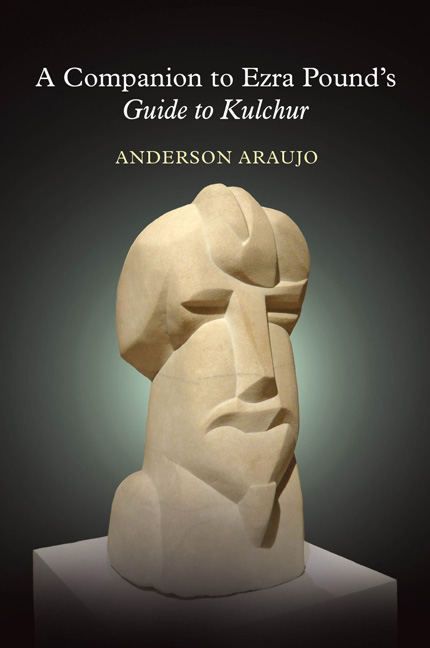Book contents
- Frontmatter
- Contents
- Acknowledgments
- Abbreviations
- Introduction
- Guide to Kulchur
- Part I
- Section I
- Section II
- Part II
- Section III
- Section IV
- Part III
- Section V
- Section VI
- Part IV
- Section VII
- Section VIII
- Section IV
- Part V
- Section X
- Section XI
- Part VI
- Section XII
- Section XIII
- Addenda: 1952
- Notes
- Index
Introduction
- Frontmatter
- Contents
- Acknowledgments
- Abbreviations
- Introduction
- Guide to Kulchur
- Part I
- Section I
- Section II
- Part II
- Section III
- Section IV
- Part III
- Section V
- Section VI
- Part IV
- Section VII
- Section VIII
- Section IV
- Part V
- Section X
- Section XI
- Part VI
- Section XII
- Section XIII
- Addenda: 1952
- Notes
- Index
Summary
The genesis of Guide to Kulchur can be traced to January 27, 1933, just three days shy of Ezra Pound's fateful meeting with the Fascist dictator Benito Mussolini in the Palazzo Venezia in Rome. In a letter typed on Faber & Faber stationery, Frank V. Morley, a director at the illustrious London publishing house, suggested that Pound write an autobiography. With eventful decades of self-exile behind him in London, Paris, and, since 1924, Rapallo, a resort town on the Ligurian coast of Italy, the forty-seven-year-old writer was the living embodiment of the modernist revolution in the arts and letters. Morley dubbed the would-be book Rough Rider. Odd title, this. Even today it is more likely to evoke a rugged cowboy on the American Old West frontier than a celebrated poet on the Italian Riviera. Yet it is surprisingly apt.
Born in 1885 in Hailey, in the Territory of Idaho, Pound did indeed utter his first cries in the world conjured by Morley's moniker. The parallels run deep. The legendary First United States Volunteer Cavalry, widely known as the Rough Riders, became a fearsome fighting force under the command of Assistant Secretary of the Navy and future U.S. president Theodore Roosevelt during the Spanish-American War. It was a motley crew made up of cowboys, Native Americans, soldiers, hunters, and ex-clergymen, mostly from the West, but also doctors, Ivy League athletes, professional gamblers, and even a champion tennis player and a polo player from the East. It was the only volunteer unit to engage in combat during the 1898 conflict. Roosevelt's bestseller The Rough Riders (1899) chronicles the exploits of his ragtag regiment, “lawless spirits who dwell on the border-land between civilization and savagery.” As it happens, this is also the portrait of the poet etched in Pound's Hugh Selwyn Mauberley (1920), “seeing he had been born / In a half savage country, out of date; / Bent resolutely on wringing lilies from the acorn.”
Guide to Kulchur is the record of Pound's most sustained effort to “wring lilies,” or eke out meaning, from a range of borderlands between history, culture, and memory. It is an exploratory experiment.
- Type
- Chapter
- Information
- A Companion to Ezra Pound's Guide to KulcherGuide to Kulcher, pp. 1 - 18Publisher: Liverpool University PressPrint publication year: 2018

